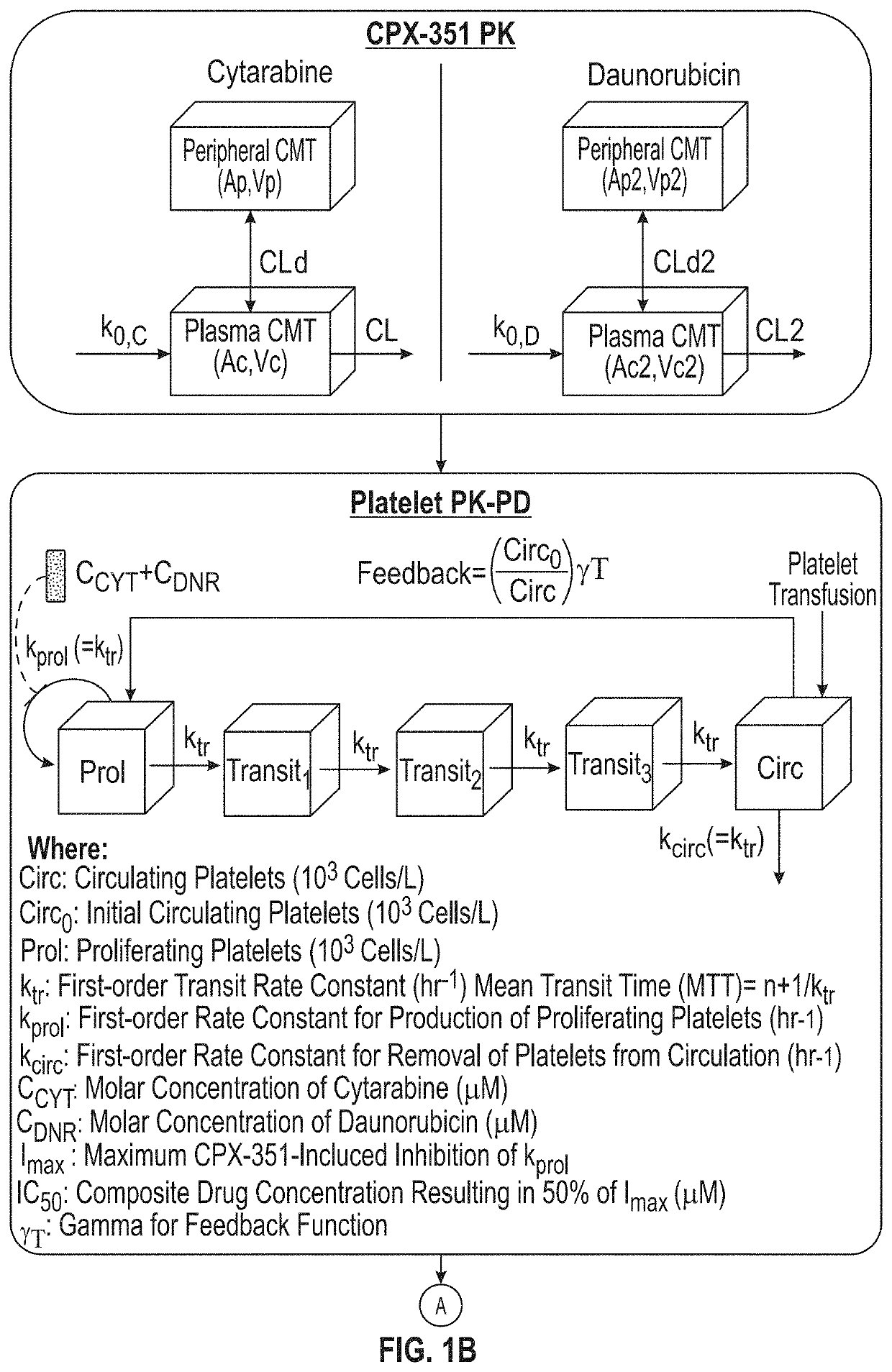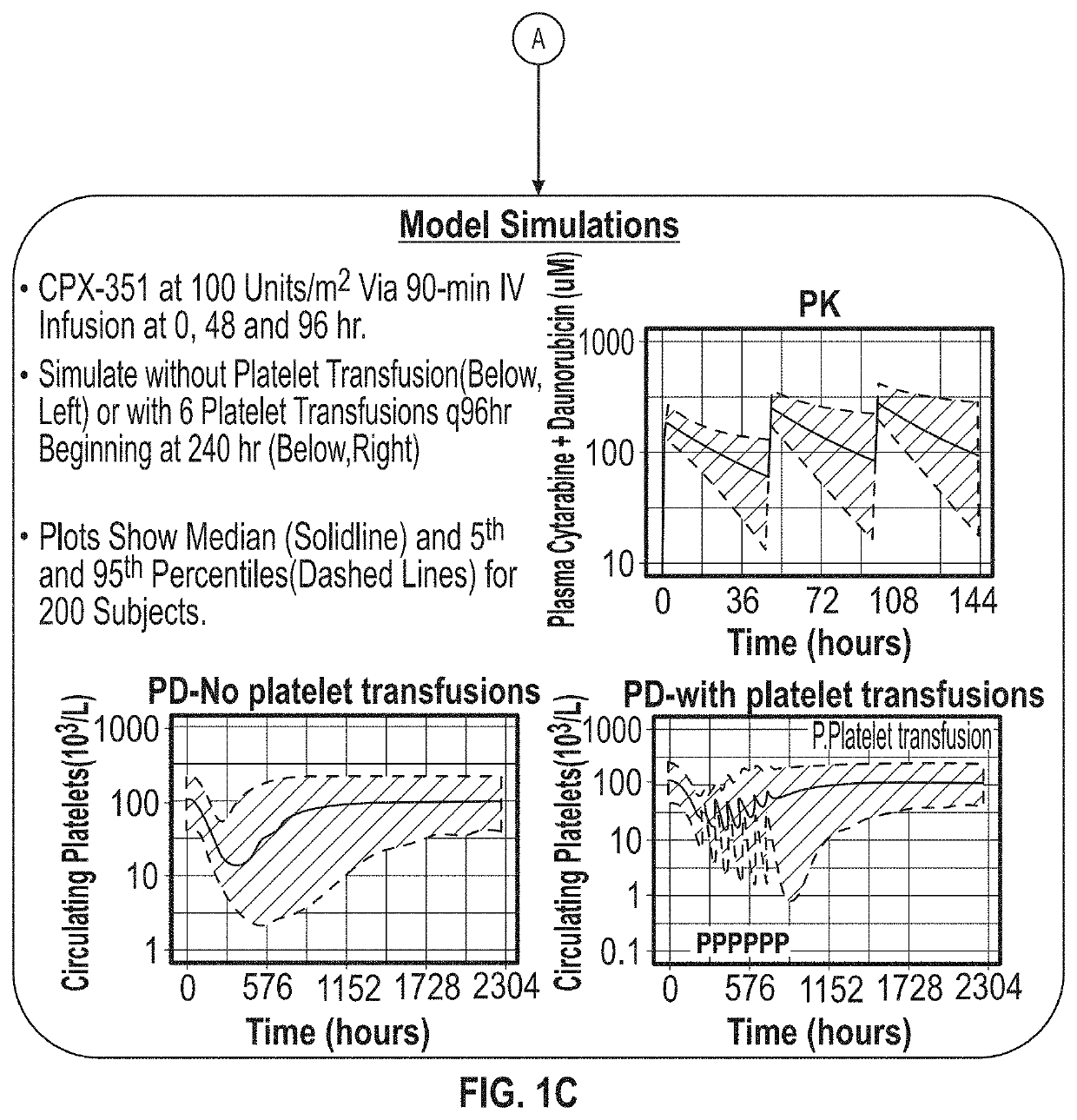Low-intensity treatment of hematological disorders
a hematological disease and low-intensity treatment technology, applied in the field of compositions and methods, can solve the problems of affecting the regulation of gene expression, causing free radical damage to dna, and many patients with hematological malignancies are ineligible for standard intensive chemotherapy treatmen
- Summary
- Abstract
- Description
- Claims
- Application Information
AI Technical Summary
Benefits of technology
Problems solved by technology
Method used
Image
Examples
example 1
Population Pharmacokinetic-Pharmacodynamic (PK-PD) Modeling of 7+3 or CPX-351-Induced Thrombocytopenia
[0076]The following CPX-351 studies were used for PK-PD Modeling:
[0077]Study 101[0078]Phase 1, open-label, dose-escalation study of CPX-351 in 48 adults with relapsed / refractory AML, ALL, or MDS[0079]CPX-351 Dosages: 3 to 134 units / m2 (1 unit=1 mg of cytarabine and 0.44 mg of daunorubicin) via 90-minute intravenous (IV) infusion on Days 1, 3, and 5[0080]PK Data Collection: Intensive sampling on Days 1, 3, and 5[0081]PD Data Collection: Pre-dose; on Days 1, 2, 3, 4, 5, 7, 14, 21, 28, 35, 42, and 56; and at follow-up (30 days after study discontinuation)
[0082]Study 206[0083]Phase 2, open-label study of CPX-351 in 26 adults with AML, ALL, or MDS[0084]CPX-351 dosages[0085]Induction: 100 units / m2 (100 mg / m2 cytarabine+44 mg / m2 daunorubicin) via 90-minute IV infusion on Days 1, 3, and 5 (2nd induction: Days 1 and 3)[0086]Consolidation: 65 units / m2 (65 mg / m2 cytarabine+29 mg / m2 daunorubici...
example 2
Modeling of Chemotherapy-induced Neutropenia (CIN) in Patients Treated With CPX-351 and “7+3”
[0108]The CPX-351 and 7+3 studies and Cytarabine / Daunorubicin modeling was performed as in Example 1.
[0109]Results shown below:
TABLE 4Population PK Parameters for GCSF AgentsPopulation mean InterindividualParameterequationvariabilityReferenceFilgrastimF10.105—Wiczling et al.5 ka, h−10.403—Wiczling et al.5 F20.586—Wiczling et al.D2, h6.6—Wiczling et al.KD, nM0.02370.527 (72.6% CV)Melhem et al.CL, L / h0.833•(WTKG / 70)0.641 0.138 (37.1% CV)Melhem et al.Vc, L3.12•(WTKG / 70)0.943 0.080 (28.2% CV)Melhem et al.PegfilgrastimF10.6460.194 (44.0% CV)Melhem et al.ka, h−10.01880.051 (22.5% CV)Melhem et alKD, nM0.09590.527 (72.6% CV)Melhem et al.CL, L / h0.362•(WTKG / 70)0.641 0.138 (37.1% CV)Melhem et al.Vc, L5.76•(WTKG / 70)0.943 0.080 (28.2% CV)Melhem et al.Filgrastim or pegfilgrastimkint, h−10.1130.325 (57.0% CV)Melhem et al.PK, pharmacokinetic; GCSF, granulocyte colony-stimulating factor; F1, bioavailability ...
example 3
Simulation of Alternative Dose-Regimen for CPX-351
[0118]Simulation of myelosuppression profile for lower dose / regimen scenarios:[0119]Day 1+5; various doses[0120]Day 1+8; various doses[0121]Day 1+8+15; various doses[0122]Other schemes, various doses
[0123]The PK / PD modeling described in Examples 1 and 2 is used to further examine the cell cycle time and Vyxeos treatment effect.
[0124]Simulation Outcomes for Absolute Neutrophil Count (ANC): Simulations were conducted using previous developed mechanistic PK / PD model for absolute neutrophil count. FIG. 8 shows the period of ANC below 500 / uL after administration of CPX-351. The duration of ANC<500 / uL increases as dose increases. Depending on regimen, the duration can be different for a given dose. The duration ANC suppression after Vyxeos standard Day 1, 3, & 5 regimen or 7+3 treatment is also shown in the figure, where Vyxeos showed a longer duration of ANC suppression than 7+3. This longer suppression is consistent with clinical observa...
PUM
| Property | Measurement | Unit |
|---|---|---|
| median time | aaaaa | aaaaa |
| median time | aaaaa | aaaaa |
| median time | aaaaa | aaaaa |
Abstract
Description
Claims
Application Information
 Login to View More
Login to View More - R&D
- Intellectual Property
- Life Sciences
- Materials
- Tech Scout
- Unparalleled Data Quality
- Higher Quality Content
- 60% Fewer Hallucinations
Browse by: Latest US Patents, China's latest patents, Technical Efficacy Thesaurus, Application Domain, Technology Topic, Popular Technical Reports.
© 2025 PatSnap. All rights reserved.Legal|Privacy policy|Modern Slavery Act Transparency Statement|Sitemap|About US| Contact US: help@patsnap.com



